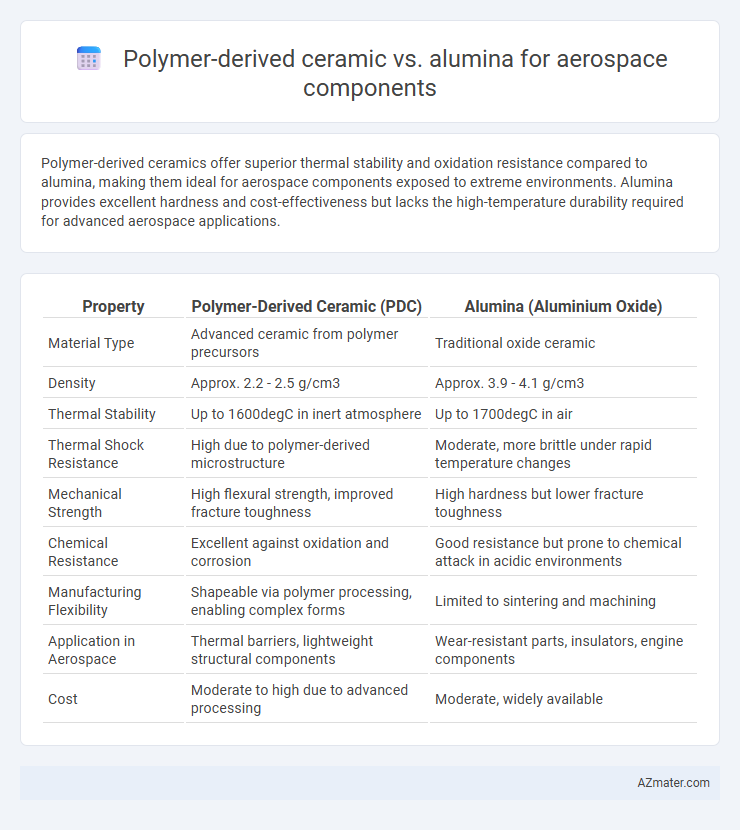Polymer-derived ceramics offer superior thermal stability and oxidation resistance compared to alumina, making them ideal for aerospace components exposed to extreme environments. Alumina provides excellent hardness and cost-effectiveness but lacks the high-temperature durability required for advanced aerospace applications.
Table of Comparison
| Property | Polymer-Derived Ceramic (PDC) | Alumina (Aluminium Oxide) |
|---|---|---|
| Material Type | Advanced ceramic from polymer precursors | Traditional oxide ceramic |
| Density | Approx. 2.2 - 2.5 g/cm3 | Approx. 3.9 - 4.1 g/cm3 |
| Thermal Stability | Up to 1600degC in inert atmosphere | Up to 1700degC in air |
| Thermal Shock Resistance | High due to polymer-derived microstructure | Moderate, more brittle under rapid temperature changes |
| Mechanical Strength | High flexural strength, improved fracture toughness | High hardness but lower fracture toughness |
| Chemical Resistance | Excellent against oxidation and corrosion | Good resistance but prone to chemical attack in acidic environments |
| Manufacturing Flexibility | Shapeable via polymer processing, enabling complex forms | Limited to sintering and machining |
| Application in Aerospace | Thermal barriers, lightweight structural components | Wear-resistant parts, insulators, engine components |
| Cost | Moderate to high due to advanced processing | Moderate, widely available |
Introduction to Aerospace Materials
Polymer-derived ceramics (PDCs) offer superior high-temperature stability and oxidation resistance compared to traditional alumina, making them increasingly valuable for aerospace components exposed to extreme environments. Alumina, known for its excellent electrical insulation and mechanical strength, remains widely used but has limitations in thermal shock resistance and fracture toughness. Advances in PDC technology enable the fabrication of lightweight, thermally resilient parts with enhanced durability, pushing the boundaries of aerospace material performance.
Overview of Polymer-Derived Ceramics (PDCs)
Polymer-Derived Ceramics (PDCs) are advanced materials synthesized through the pyrolysis of preceramic polymers, offering exceptional thermal stability and oxidation resistance crucial for aerospace components. Their amorphous microstructure ensures high fracture toughness and damage tolerance compared to crystalline ceramics like alumina, enhancing component longevity under extreme conditions. PDCs enable the fabrication of complex shapes through molding and curing processes, providing design flexibility that alumina's sintering methods often lack.
Alumina: Properties and Applications
Alumina (Al2O3) is widely used in aerospace components due to its exceptional hardness, high thermal stability, and excellent wear resistance, which allow it to withstand extreme environmental conditions. Its superior electrical insulation properties and resistance to oxidation make alumina ideal for insulating components and structural parts exposed to high temperatures. Alumina's applications include turbine blades, thermal barrier coatings, electrical insulators, and engine components where durability and performance under thermal stress are critical.
Mechanical Performance: PDCs vs Alumina
Polymer-derived ceramics (PDCs) offer superior fracture toughness and thermal shock resistance compared to alumina, making them more reliable under extreme aerospace conditions. PDCs maintain structural integrity at high temperatures up to 1600degC, whereas alumina typically softens above 1400degC, limiting its use in high-heat environments. Mechanical performance metrics highlight PDCs' enhanced strength-to-weight ratio and improved resistance to microcracking, critical for aerospace components subjected to cyclic thermal and mechanical stresses.
Thermal Stability and Resistance Comparison
Polymer-derived ceramics (PDCs) exhibit superior thermal stability compared to alumina, maintaining structural integrity at temperatures exceeding 1600degC, whereas alumina typically withstands up to 1500degC. The inherent SiCN or SiOC networks in PDCs provide enhanced oxidation resistance and thermal shock resilience, critical for aerospace components operating in extreme thermal environments. Alumina, while offering good wear resistance, is more prone to microcracking under rapid thermal cycling, limiting its performance in high-temperature aerospace applications.
Manufacturing Processes and Scalability
Polymer-derived ceramics (PDCs) offer advanced manufacturing flexibility through processes like additive manufacturing and rapid prototyping, enabling complex geometries and reduced material waste, unlike traditional alumina ceramics that rely on conventional sintering and machining techniques. Scalability for PDCs remains challenging due to higher costs and process sensitivity but promises enhanced thermal and mechanical properties crucial for aerospace components. Alumina ceramics benefit from well-established, cost-effective large-scale production methods, but their manufacturing limits the design complexity and often requires post-processing to meet aerospace standards.
Weight and Density Considerations
Polymer-derived ceramics (PDCs) offer significantly lower density compared to alumina, typically ranging from 2.2 to 2.8 g/cm3 versus alumina's 3.9 to 4.1 g/cm3, making PDCs advantageous for weight-sensitive aerospace components. This reduced density directly contributes to improved fuel efficiency and performance in aerospace applications where every gram matters. The weight savings from PDCs enable design flexibility and can lead to enhanced payload capacity without compromising structural integrity.
Corrosion and Oxidation Resistance
Polymer-derived ceramics exhibit superior oxidation resistance compared to alumina in aerospace components, maintaining structural integrity at elevated temperatures beyond 1400degC. Their intrinsic silicon-based matrices form protective silica layers that effectively prevent corrosion in aggressive oxidative environments encountered during flight. Alumina, while corrosion-resistant, tends to degrade faster under cyclic thermal stresses, making polymer-derived ceramics more reliable for high-performance aerospace applications requiring long-term oxidative durability.
Cost Analysis and Availability
Polymer-derived ceramics offer cost advantages over traditional alumina in aerospace components due to lower raw material costs and simpler processing techniques, enhancing affordability for complex geometries. Alumina remains widely available with established supply chains, ensuring consistent accessibility but often incurs higher machining and sintering expenses. The choice between polymer-derived ceramics and alumina hinges on balancing material availability, production scalability, and total lifecycle cost for aerospace applications.
Future Trends in Aerospace Component Materials
Polymer-derived ceramics (PDCs) offer superior thermal stability and oxidation resistance compared to alumina, making them promising for high-temperature aerospace components. Future trends emphasize the integration of PDCs with additive manufacturing techniques to achieve complex geometries and enhanced mechanical properties. Continued research on nanocomposite formulations aims to improve toughness and reduce brittleness, positioning PDCs as a key innovation in next-generation aerospace materials.

Infographic: Polymer-derived ceramic vs Alumina for Aerospace component
 azmater.com
azmater.com